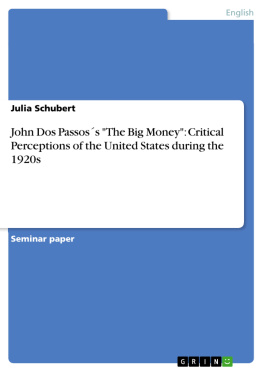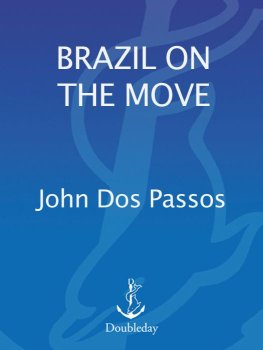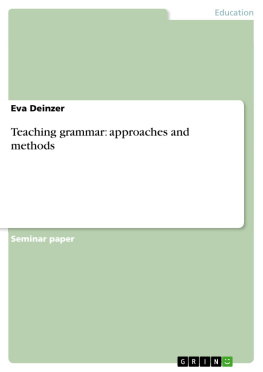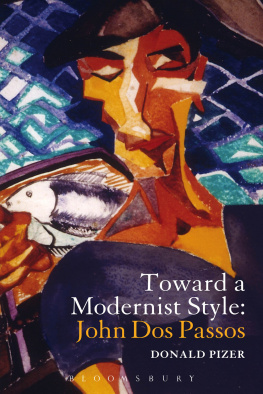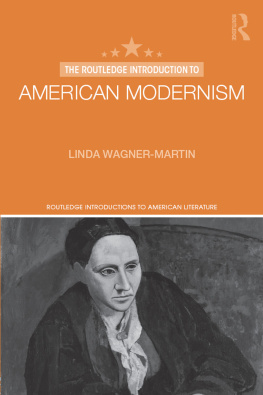Martin-Luther-Universitt Halle-Wittenberg
Institut fr Anglistik und Amerikanistik
Hauptseminar: Modernism and Its Others: U.S.-American Literature and Culture in the 1920s
WS 2004/2005
Hauptseminararbeit
John Dos Passoss The Big Money: Critical Perceptions of the United States during the 1920s
Julia Schubert
Email juliaschubert@gmx.net
(Magister - Hauptfach Politikwissenschaft; 1. Nebenfach Medien- und Kommunikationswissenschaften, 2. Nebenfach Anglistik)
Table of Content
Introduction
U.S.A.
Modes of Narration
3.1 Fictional Characters
3.2 Biographies
3.3 Newsreels
3.4 The Camera Eye
The Big Money
4.1 Historical Context
4.2 Fictional Characters
4.2.1 Charley Anderson
4.2.2 Margo Dowling
4.2.3 Mary French
4.2.4 Richard Ellsworth Savage
5. Themes
Conclusion
Bibliography
1. Introduction
When the French philosopher, critic and writer Jean-Paul Sartre concluded an essay on the American novelist John Dos Passos in 1938 with the words I regard Dos Passos as the greatest writer of our time it was quite clear that the author of the trilogy U.S.A. had joined the class of the most important and influential writers in American literature.
The three novels of the trilogy are critical documents and portraits of the history and life of the American nation during the first three decades of the 20th century. U.S.A. is a social and political work that is shaped by the stylistic experimentation of the author who treats art in the service of history and therefore leaves him in a literary outstanding position.
This term paper aims to explain and justify this position of Dos Passos by examining and analyzing The Big Money which was the final novel of U.S.A. First of all, this work will give an overview and assessment of the trilogy as a whole to facilitate an analytical insight into its meaning and purpose. Secondly, the four different styles of narration will be discussed. The third part of the paper will deal with The Big Money: What is the historical context of the novel? Who are the main characters? Finally, the themes of the novel will be shortly summarized in the fourth part of this paper.
2. U.S.A.
The American novelist, play writer, poet, writer of historical and political nonfiction, and self-styled chronicler John Dos Passos (1896-1970) wrote the three novels The 42nd Parallel (1930), 1919 (1932) and The Big Money (1936) that make up the trilogy U.S.A. between 1927 and 1936 Therefore, U.S.A. is a negative and pessimistic history that depicts a critical historical, social and moral development of the American nation by producing a montage of exemplary destinies, short biographies of famous Americans, autobiographical memories of the author and collages of texts history and fiction are presented unseparated.
When the first two novels where published, Dos Passos who was publicly committed to the Radical Left was regarded as a Communist. With the publishing of the final novel it ultimately became clear that he was also critical of Communism.
The author aimed to produce a satire on American life, permeated with popular songs, current events, and headlines, that would truly portray the whole of American culture and events and expresses Dos Passoss view of the ill effects of capitalism on the American people.
The work as Dos Passos puts it is a collective novel about the march of history, made up mostly of the speech of the people. There is no individual hero; furthermore the protagonist is a social group. U.S.A. confronts class conflict, and it examines the trauma inflicted by rapid modernization on both the fabric of social life and the individual human psyche.
In content the trilogy describes three phases of the declining history of the United States. The 42nd Parallel covers the years from 1900 until Americas war entry in 1917. This first novel presents twentieth-century hopes for the new nation and moves towards the rise of the progressive impulse and radical challenges to the capitalist system; it goes over to the European battlefields. In 1919 the war is the main concern; it is seen as the plot of the big interest, as a place of horror, debasement, new sexual opportunity, rising revolutionary momentum. It culminates in the Russian Revolution for which there is no western parallel (U.S.A . is not only concerned with internal affairs of the U.S. but also with those of international interest). The novel ends in the corrupted idealism of the Versailles conference while there is the general strike of 1 May 1919 in the U.S. that collapses into Red Scare. The path towards commercialism and superpower capitalism is opened. The Big Money is set in the 1920s. It portrays a society that is economically cohesive, socially divisive, emotionally and personally destructive. The emotional collapse of the main characters and the economic wasting of the system run parallel. The end of all progressive social hope is marked by the deaths of Sacco and Vanzetti.
In technical terms the trilogy is a result of experimentation inspired by cinematic influences - Eisensteins and Griffith understanding of montage. Elements of reportage and documentary are included in the Newsreels. Minute biographies and a large range of fictional characters give an objective frame to the Camera Eye which adds a subjective element to the novels. Intersections between documentary matter and naturalistic materials are used to create a massive modernist epic.
3. Modes of Narration
3.1 Fictional Characters
The trilogy U.S.A. contains dozens of characters whose lives are not systematically woven into a main plot but float incessantly within the process of a certain phase of history. None of the characters is a typical hero or individual protagonist of a novel. None of them dominates the picture, no single force drives toward a conclusion. Some of them occur in all three novels but the importance of the role they play may differ from novel to novel.
The characters are ordinary citizens who represent the American society of that time, they are average Americans. Their individual stories are tales of types. Some of these tales intersect, others run parallel, some continue for the entire sequence and others drop out from sight. Although these people are typical Americans they do not compose a representative picture of all kinds of people in this society Dos Passos made a limited selection of fictional characters. Some social groups are not included at all or only play a minor role, such as Non-White Americans or people in rural areas. The occurring characters belong to the broad middle class.
As in satire the fictional characters are always seen from above. There is no chance for the reader to identify with them, to be touched by their lives or to develop sympathies for them. The reason for that lies in the characters lack of ideas there is no reflection or consequential thought that is not connected with their appetites. These people are almost entirely occupied with their sensations and their longings. The fact that Charley Anderson loses custody of his children is also presented with only a few words and does not evoke any sympathy.
There is no pattern of the characters occurrence, only little progress, growth and development shape their role in the trilogy and the reader is not able to see any difference between the space of their interior and exterior lives
The development of the modern American society with its dehumanization and loss of individuality, the impact of technological improvements and industrial modernization, and the hunger for power, wealth, influence and success are represented in the characters stories. This is the complex of forces that molds the men and women in the novels who are short-sided people pursuing their personal aims.
Next page
